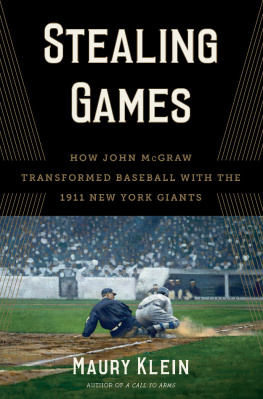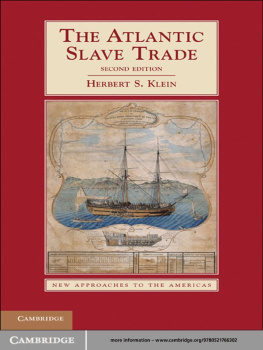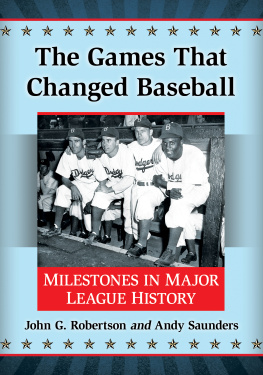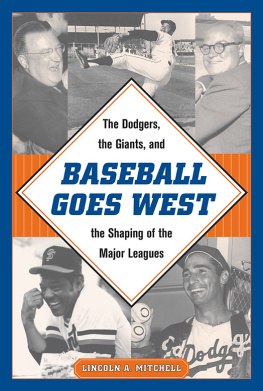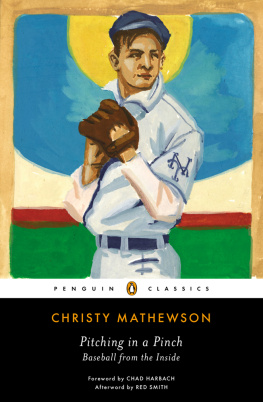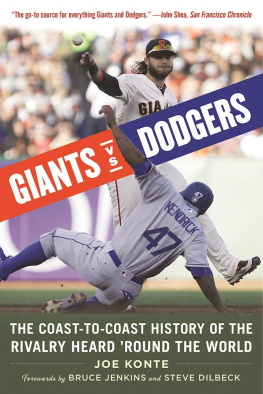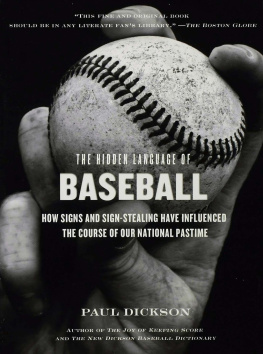For Kim, the guiding light, with love

Contents
For many decades baseball ruled as the unchallenged national pastime of the United States. No other sport or activity had yet risen to the same prominence. Between 1900 and 1914 the game as we know it evolved through changes in the rules. The National League finally stabilized, a second major league emerged in 1901 and proved enduring, and within a few years the playing of a postseason series between the two pennant winners became a much-anticipated annual ritual. This book portrays this evolving process through the story of one National League team that was instrumental in changing the game, the 1911 New York Giants.
Then as now, baseball reflected in many ways the larger world around it. America in 1900 was a nation in transition with all the strains that come with accelerating change. The business of America was fast becoming big business. Two major forces, the industrial revolution and the organizational revolution, created a new society based on large, integrated organizations using the latest technology as well as cheap labor to increase productivity. A maturing industrial system displayed all its benefits in the form of a spectacular output of goods and all its liabilities in the host of social and economic problems that accompanied it.
The first generation of Americans born into an industrial society was coming of age and confronting these problems. Their efforts and the confusion surrounding them gave rise to a powerful but amorphous movement called Progressivism, which at its best looked to harness the forces of change to create a more orderly, stable, and humane nation. But that task grew ever more difficult because change came to American life at an ever-quickening pace. Everything seemed to be going faster, especially in the cities, those hotbeds of change. Then, between 1914 and 1918, a global cataclysm put an abrupt and unexpected end to the prewar world.
Baseball reflected these changes as it did so much else of American life. Managers increasingly referred to their teams as a machine, the parts of which had to be integrated as perfectly as possible to function effectively. Every player, however great his talent, was considered a single part of that machine. To win, a team had to perform as smoothly as a well-run production line. Maximum output depended not only on smooth coordination but speed as well, the ability to play the game at a faster and more alert pace than rival teams.
The two most obvious symbols of that faster pace in society were the automobile and the airplane. Baseball embodied it in the form of a new approach to the game that emerged in the 1890s with the Baltimore Orioles. Where teams had always preferred large, burly players who could hit the ball with authority, the Orioles built their team around speed, deception, clever play, and, above all, aggressiveness. Like the titans of industry they gave no quarter and asked none. Like George Washington Plunkitt, the fabled Tammany ward leader, they saw their opportunities and did whatever was necessary to win, sharpening both their spikes and their wits. Umpires no less than rival players became the targets of their belligerence. In the process they introduced or refined new tactics such as the hit-and-run, Baltimore chop, and delayed steal, and paid close attention to the smallest details of the contest.
Along with several championships the Orioles produced a crop of outstanding major league managers, such as Hughie Jennings, Wilbert Robinson, and Kid Gleason, who had imbibed the new style thoroughly. Foremost among them was John J. McGraw, who managed the Orioles briefly before leaving to oversee the New York Giants in 1902. He remained in that post for thirty-one years and compiled a record never equaled. During his reign the Giants won ten pennants and three World Series while finishing lower than fourth only twice. Even his worst enemies acknowledged his genius at every aspect of the game. The little Napoleon, as the sportswriters dubbed him, was a man of startling contradictions, as fiercely combative on the field as he was generous and giving off of it. The style of play he introduced lasted for more than two decades before giving way grudgingly to the era of the long ball.
A word about statistics and box scores of the era. While the figures given in modern record books are doubtless the best we have, in 1911 scorekeepers were still trying to standardize their methods. My study leans heavily on contemporary newspaper accounts because baseball was followed so closely in the dailies by then. However, the sportswriters often did not agree either on the details of their scoring of a game or even on what actually happened, let alone the mood or attitude of the players involved. New York in 1911 had thirteen major daily newspapers; I have examined six or seven of them closely, as well as one Chicago and one St. Louis paper, and gleaned material from some of the others too. I also consulted the full set of box scores in Sporting Life, which billed itself as the official record of the National League. Comparing different accounts of any given game can be a frustrating experience, and at many points of disagreement among them I tended to rely on majority opinion.
In writing this book several people proved invaluable in the help they rendered. Emily Greene has been my go-to person at the University of Rhode Islands Carothers Library for many years. As with so many other books, she somehow managed to find for me nearly every source I asked for. At the National Hall of Fame Cassidy Lent expedited my research in many ways, not least of which was making available a wide range of source materials. My longtime agent, Marian Young, encouraged the project from the beginning, for which I am grateful as always. The book began its life under the aegis of Peter Ginna, my editor on other projects at Bloomsbury USA, but he left the house shortly after I started work. George Gibson stepped in as reliever and provided continual encouragement and enthusiasm throughout the writing process. I am grateful for his support. Once again my wife, Kim, endured my daily retreats to my basement office. Her support helped immensely to bring the book into being.
Maury Klein
Saunderstown, Rhode Island
When you train under most managers, you merely get yourself in good physical condition. When you train under McGraw, you learn baseball.
R OGERS H ORNSBY
He treats his players fairly, gives each one the same deal, is the absolute boss, and plans his games and executes his moves with the precision of an expert chess player maneuvering his pieces. McGraw will not brook insubordination, and has a tongue which will cut any man who crosses him in his judgment. He never gives up, and this spirit of his has been soaked up by the players on the Giants He drives unmercifully, and forgets everything about the battle when it is over.
L ITERARY D IGEST
Igor Stravinskys revolutionary ballet, Le Sacre du printemps, would not appear for another two years, but in the United States most men, along with a surprising number of women, knew well and awaited eagerly our own version of the rite of spring built around the undisputed national pastime, baseball. In December the hot stove league heated up, fueled by rumors and fantasies of trades, acquisitions, and retirements. Within only a few weeks that sometimes seemed as long as geological eras the scattered practitioners of the game would leave their mundane off-season lives and occupations to congregate in camps designed to whip them into competitive shape and sharpen their instincts for the game they were fortunate enough to play for pay, however tough the toll on their minds and bodies.
Next page
